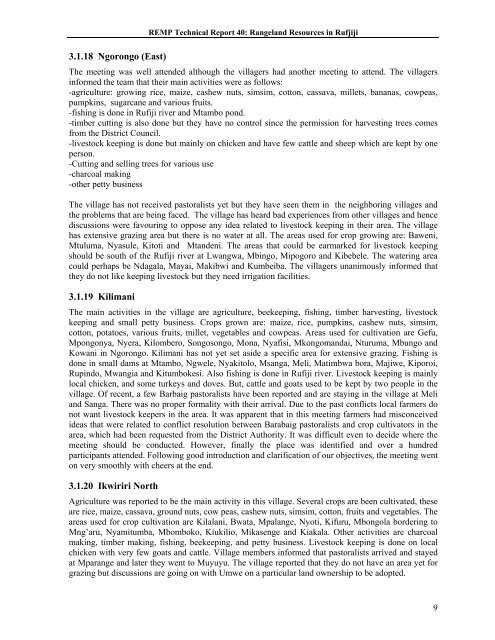rufiji environment management project - Coastal Forests of Kenya ...
rufiji environment management project - Coastal Forests of Kenya ...
rufiji environment management project - Coastal Forests of Kenya ...
Create successful ePaper yourself
Turn your PDF publications into a flip-book with our unique Google optimized e-Paper software.
REMP Technical Report 40: Rangeland Resources in Rufjiji<br />
3.1.18 Ngorongo (East)<br />
The meeting was well attended although the villagers had another meeting to attend. The villagers<br />
informed the team that their main activities were as follows:<br />
-agriculture: growing rice, maize, cashew nuts, simsim, cotton, cassava, millets, bananas, cowpeas,<br />
pumpkins, sugarcane and various fruits.<br />
-fishing is done in Rufiji river and Mtambo pond.<br />
-timber cutting is also done but they have no control since the permission for harvesting trees comes<br />
from the District Council.<br />
-livestock keeping is done but mainly on chicken and have few cattle and sheep which are kept by one<br />
person.<br />
-Cutting and selling trees for various use<br />
-charcoal making<br />
-other petty business<br />
The village has not received pastoralists yet but they have seen them in the neighboring villages and<br />
the problems that are being faced. The village has heard bad experiences from other villages and hence<br />
discussions were favouring to oppose any idea related to livestock keeping in their area. The village<br />
has extensive grazing area but there is no water at all. The areas used for crop growing are: Baweni,<br />
Mtuluma, Nyasule, Kitoti and Mtandeni. The areas that could be earmarked for livestock keeping<br />
should be south <strong>of</strong> the Rufiji river at Lwangwa, Mbingo, Mipogoro and Kibebele. The watering area<br />
could perhaps be Ndagala, Mayai, Makibwi and Kumbeiba. The villagers unanimously informed that<br />
they do not like keeping livestock but they need irrigation facilities.<br />
3.1.19 Kilimani<br />
The main activities in the village are agriculture, beekeeping, fishing, timber harvesting, livestock<br />
keeping and small petty business. Crops grown are: maize, rice, pumpkins, cashew nuts, simsim,<br />
cotton, potatoes, various fruits, millet, vegetables and cowpeas. Areas used for cultivation are Gefu,<br />
Mpongonya, Nyera, Kilombero, Songosongo, Mona, Nyafisi, Mkongomandai, Nturuma, Mbungo and<br />
Kowani in Ngorongo. Kilimani has not yet set aside a specific area for extensive grazing. Fishing is<br />
done in small dams at Mtambo, Ngwele, Nyakitolo, Msanga, Meli, Matimbwa bora, Majiwe, Kiporoi,<br />
Rupindo, Mwangia and Kitumbokesi. Also fishing is done in Rufiji river. Livestock keeping is mainly<br />
local chicken, and some turkeys and doves. But, cattle and goats used to be kept by two people in the<br />
village. Of recent, a few Barbaig pastoralists have been reported and are staying in the village at Meli<br />
and Sanga. There was no proper formality with their arrival. Due to the past conflicts local farmers do<br />
not want livestock keepers in the area. It was apparent that in this meeting farmers had misconceived<br />
ideas that were related to conflict resolution between Barabaig pastoralists and crop cultivators in the<br />
area, which had been requested from the District Authority. It was difficult even to decide where the<br />
meeting should be conducted. However, finally the place was identified and over a hundred<br />
participants attended. Following good introduction and clarification <strong>of</strong> our objectives, the meeting went<br />
on very smoothly with cheers at the end.<br />
3.1.20 Ikwiriri North<br />
Agriculture was reported to be the main activity in this village. Several crops are been cultivated, these<br />
are rice, maize, cassava, ground nuts, cow peas, cashew nuts, simsim, cotton, fruits and vegetables. The<br />
areas used for crop cultivation are Kilalani, Bwata, Mpalange, Nyoti, Kifuru, Mbongola bordering to<br />
Mng’aru, Nyamitumba, Mbomboko, Kiukilio, Mikasenge and Kiakala. Other activities are charcoal<br />
making, timber making, fishing, beekeeping, and petty business. Livestock keeping is done on local<br />
chicken with very few goats and cattle. Village members informed that pastoralists arrived and stayed<br />
at Mparange and later they went to Muyuyu. The village reported that they do not have an area yet for<br />
grazing but discussions are going on with Umwe on a particular land ownership to be adopted.<br />
9

















